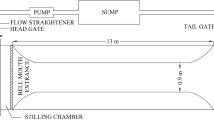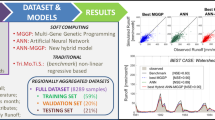Abstract
Use of genetic programming (GP) in the field of river engineering is rare. During flood when the water overflows beyond its main course known as floodplain encounters various obstacles through rough materials and vegetation. Again the flow behaviour becomes more complex in a compound channel section due to shear at different regions. Discharge results from the experimental channels for varying roughness surfaces, along with data from a compound river section, are used in the GP. Model equations are derived for prediction of discharge in the compound channel using five hydraulic parameters. Derived models are tested and compared with other soft computing techniques. Few performance parameters are used to evaluate all the approaches taken for analysis. From the sensitivity analysis, the effects of parameters responsible for the flow behaviour are inferred. GP is found to give the most potential results with the highest level of accuracy. This work aims to benefit the researchers studying machine learning approaches for application in stream flow analysis.











Similar content being viewed by others
References
K.K. Khatua, K.C. Patra, P.K. Mohanty, Stage discharge prediction for straight and smooth compound channels with wide floodplains. J. Hydraul. Eng. ASCE 138(1), 93–99 (2012)
A.J. Abebe, R.K. Price, Information theory and neural networks for managing model uncertainty in flood routing. J. Comput. Civil Eng. ASCE 18(4), 377–380 (2004)
A.K. Kordon, Future trends in soft computing industrial applications, in Proceedings of the 2006 IEEE Congress on Evolutionary Computation, pp. 7854–7861 (2006)
A. Alok, K.C. Patra, S.K. Das, Prediction of discharge with Elman and cascade neural networks. Research Journal of Recent Sciences 2, 279–284 (2013)
A. Adhikari, K.C. Patra, N. Adhikari, Prediction of discharge in straight compound channels using conventional and soft computing tools. J. Eng. Res. Appl. 7(8), 42–51 (2017)
G. Akhil, G. Ankit, K. Tai, S. Sreedeep, An Integrated SRM-multi-gene genetic programming approach for prediction of safety of 3-D soil nailed slopes. Eng. Appl. Artif. Intell. 30, 30–40 (2014)
H.M. Azamathulla, A.A. Ghani, Genetic programming to predict river pipeline scour. J. Pipeline Syst. Eng. Pract. 1(3), 127–132 (2010)
D.P. Searson, D.E. Leahy, M.J. Willis, GPTIPS: an open source genetic programming toolbox for multigene symbolic regression, in Proceedings of the International Conference of Engineering and Computer Scientists, Vol. I, pp. IMECS2010, 17–19 March 2010 (2010)
P.K. Muduli, M.R. Das, P. Samui, S.K. Das, Uplift capacity of suction caisson in clay using artificial intelligence techniques. Mar. Georesour. Geotechnol. 31, 375–390 (2013)
D.S. Pandey, I. Pan, S. Das, J.J. Leahy, W. Kwapinski, Multi-gene genetic programming based predictive models for municipal solid waste gasification in a fluidized bed gasifier. Bioresour. Technol. 179, 524–533 (2015)
H. Demuth, M. Beale, Neural Network Toolbox User`s Guide (The Math Works Inc., Natick, 2004)
D.W. Knight, J.D. Demetriou, Floodplain and main channel flow interaction. J. Hydraul. Eng. ASCE 109(8), 1073–1092 (1983)
W.R.C. Myers, Velocity and discharge in compound channels. J. Hydraul. Eng. ASCE 113(6), 753–766 (1987)
B. Rezaei, Overbank flow in compound channels with prismatic and non-prismatic floodplains. Diss. University of Birmingham (2006)
S.A. Atabay, D.W. Knight, The influence of floodplain width on the stage-discharge relationship for compound channels, in River Flow 2002, Proceedings of the International Conference on Fluvial Hydraulics, Louvain-la-Neuve, Belgium, vol. 1, pp. 197–204 (2002)
L.A. Zadeh, Fuzzy sets. Inf. Control 8(3), 338–353 (1965)
S.J.R. Jang, ANFIS: adaptive-network-based FUZZY inference system. IEE Trans. Syst. Man Cybernet. 23(3), 665–685 (1993)
M.E. Keskin, D. Taylan, O. Terzi, Adaptive neural-based fuzzy inference system (ANFIS) approach for modelling hydrological time series. Hydrol. Sci. J. 51(4), 588–988 (2010)
D.P. Searson, D.P. Leahy, M.J. Willis, GPTIPS: an open source genetic programming toolbox for multigene symbolic regression, in Proceedings of the International Conference of Engineering and Computer Scientists, vol. I, p. IMECS2010, 17–19 March 2010 (2010)
E. Alfaro Cid, A.I. Esparcia-Alcázar, P. Moya, B. Femenia-Ferrer, K. Sharman, J.J. Merelo, Modelling pheromone dispensers using genetic programming. Lect. Note Comput. Sci. 5484, 635–644 (2009)
S.Y. Liong, W.H. Lim, G. Paudyal, River stage forecasting in Bangladesh: neural network approach. J. Comput. Civil Eng. ASCE 4(1), 1–8 (2002)
S. Srinivasulu, J. Ashu, A comparative analysis of training methods for artificial neural networks rainfall-runoff models. Appl. Soft Comput. 6, 295–306 (2006)
Acknowledgements
The writers acknowledge the Central Water Commission, Bhubaneswar, for providing river Brahmani data for the analysis. The paper is part of the research work carried out in the National Institute of Technology, Rourkela.
Author information
Authors and Affiliations
Corresponding author
Additional information
Publisher's Note
Springer Nature remains neutral with regard to jurisdictional claims in published maps and institutional affiliations.
Rights and permissions
About this article
Cite this article
Adhikari, A., Adhikari, N. & Patra, K.C. Genetic Programming: A Complementary Approach for Discharge Modelling in Smooth and Rough Compound Channels. J. Inst. Eng. India Ser. A 100, 395–405 (2019). https://doi.org/10.1007/s40030-019-00367-x
Received:
Accepted:
Published:
Issue Date:
DOI: https://doi.org/10.1007/s40030-019-00367-x




